
Muscle car is an American term for high-performance cars, usually rear-wheel drive and fitted with a large and powerful V8 engine. The term originated for 1960s and early 1970s special editions of mass-production cars which were designed for drag racing.

The Chevrolet Impala is a full-size car built by Chevrolet for model years 1958 to 1985, 1994 to 1996, and since 2000 onwards as a mid-size car. The Impala is Chevrolet's popular flagship passenger car and is generally among the better selling American made automobiles in the United States.

The Jaguar E-Type, or the Jaguar XK-E for the North American market, is a British sports car that was manufactured by Jaguar Cars Ltd between 1961 and 1975. Its combination of beauty, high performance, and competitive pricing established the model as an icon of the motoring world. The E-Type's 150 mph (241 km/h) top speed, sub-7-second 0 to 60 mph (97 km/h) acceleration, monocoque construction, disc brakes, rack-and-pinion steering, and independent front and rear suspension distinguished the car and spurred industry-wide changes. The E-Type was based on Jaguar's D-Type racing car, which had won the 24 Hours of Le Mans three consecutive years beginning 1955, and employed what was, for the early 1960s, a novel racing design principle, with a front subframe carrying the engine, front suspension and front bodywork bolted directly to the body tub. No ladder frame chassis, as was common at the time, was needed and as such the first cars weighed only 1315kg (2900lb).

The Dodge Lancer is an automobile which was built by Dodge. Initially introduced as a hardtop version of the full-sized 1955 Dodge, the original version was produced until 1959. In 1961, Dodge revived the Lancer nameplate on the compact Chrysler A platform, but this only remained in production for two model years before it was replaced by the Dodge Dart. For 1985, Dodge used the Lancer nameplate on a car based on the mid-sized Chrysler H platform, and this model remained in production until it was replaced by the Dodge Spirit in 1989.

The Plymouth Barracuda is a two-door automobile manufactured by Plymouth from 1964 to 1974.
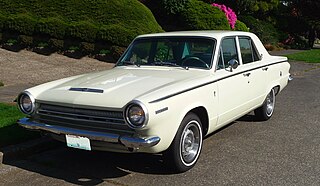
The Dodge Dart is an automobile originally built by Dodge from 1960 to 1976 in North America, with production extended to later years in various other markets. The Dart nameplate was resurrected for a Fiat-derived compact car introduced in 2013.

The Jaguar V12 engine is a V12 engine produced by Jaguar Cars. Based loosely on an earlier design for an intended Le Mans car, the Jaguar XJ13, it was first seen in the Series 3 Jaguar E-type of 1971. The V12 was only Jaguar's second engine design to go into production in the history of the company. The all-alloy block was fitted with removable wet liners and had a SOHC two-valve alloy head with flat block mating surface, and the combustion chamber in the piston crown carved in a shallow cup form. It was regarded by some as one of the premier powerplants of the 1970s and 1980s.

The Jaguar C-Type is a racing sports car built by Jaguar and sold from 1951 to 1953. The "C" stands for "competition".
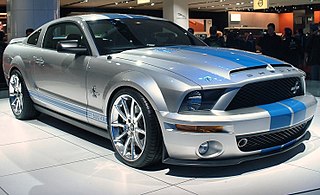
The Shelby Mustang is a high performance variant of the Ford Mustang which was built by Shelby American from 1965 to 1968, and from 1969 to 1970 by Ford. Following the introduction of the fifth generation Ford Mustang in 2005, the Shelby nameplate was revived as a new high-performance model, this time designed and built by Ford.
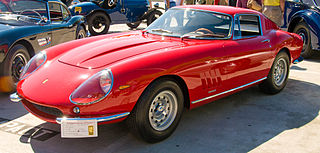
The Ferrari 275 is a series of front-engined V12-powered grand touring automobiles with two-seater coupé and spider bodies produced by Ferrari between 1964 and 1968. The first 275 series cars were powered by a 3.3 L (3286 cc) dual overhead camshaft Colombo 60° V12 engine producing 260–320 hp (190–240 kW). An updated 275 GTB/4 was introduced in 1966, with a revised four overhead camshaft engine producing 300 hp (220 kW). The 275 series were the first road-going Ferraris equipped with a transaxle and independent rear suspension.
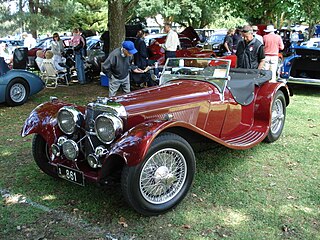
The SS Jaguar 100 is a British 2-seat sports car built between 1936 and 1941 by SS Cars Ltd of Coventry, England.

The Daewoo Tico is a city car produced by the South Korean automaker Daewoo from 1991 to 2001.

The Nissan S20 engine 2.0 L (1,990 cc) was a straight-6, DOHC internal combustion engine produced by Nissan from 1969 to 1973. It was essentially a revised production variant of the 1966 Prince GR8 engine from Prince/Nissan's R380 racecar. It produces 160 hp @ 7000 rpm and 177 N⋅m; 130 lbf⋅ft (18 kg⋅m) of torque @ 5600 rpm. The S20 weights 199 kg (439 lb).
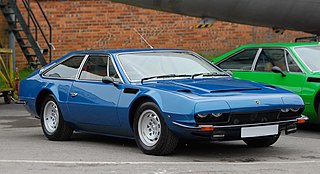
The Lamborghini Jarama is a 2+2 grand tourer manufactured and marketed by Italian car manufacturer Lamborghini between 1970 and 1976. It was styled by Bertone designer Marcello Gandini.

The Jaguar Mark 2 is a medium-sized saloon car built from late 1959 to 1967 by Jaguar in Coventry, England. The outmoded Jaguar 2.4 Litre and 3.4 Litre models made between 1955 and 1959 are identified as Mark 1 Jaguars.
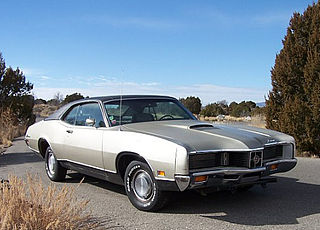
Mercury Cyclone is an automobile that was marketed by the Mercury division of Ford from 1964 to 1971. Introduced in 1964 as the Mercury Comet Cyclone, the Cyclone replaced the S-22 as the performance-oriented version of the Mercury Comet model line. The Cyclone became a distinct nameplate for the 1968 model year, as the Mercury Montego was phased in to replace the Comet.

The Jaguar Mark VIII is a luxury four-door sports sedan introduced by the Jaguar company of Coventry at the 1956 London Motor Show.

The Jaguar XK8 is a 2-door grand tourer launched by Jaguar Cars in 1996, and was the first generation of a new XK series. The XK8 was available in three-door hatchback coupé or two-door convertible body styles with the new 4.0-litre Jaguar AJ-V8 engine. In 1998, the XKR was introduced with a supercharged version of the engine. In 2003, the engines were replaced by the new 4.2-litre AJ34 engines in both the normally aspirated and supercharged variations. The first-generation of the XK series shares its Jaguar XJS-derived platform with the Aston Martin DB7, both cars tracing their history back to an abandoned Jaguar development study in the mid-1980s known as XJ41/XJ42, which had been mooted to be known as the F-Type.
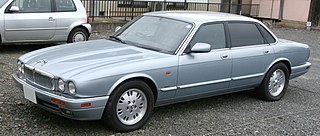
The Jaguar XJ (X300) is a full-size luxury sedan manufactured by Jaguar Cars between 1994 and 1997. It was the first XJ produced entirely under Ford ownership, and can be considered an evolution of the outgoing XJ40 generation. Like all previous XJ generations, it features the Jaguar independent rear suspension arrangement. The design of the X300 placed emphasis on improved build quality, improved reliability, and a return to traditional Jaguar styling elements.
David Brown Automotive is a British manufacturer of limited edition automobiles in Silverstone, England, belonging to British businessman David Brown. The company began in Coventry in 2013 and moved to a new 18,000 sq ft dedicated build facility and headquarters in Silverstone in April 2017.






















